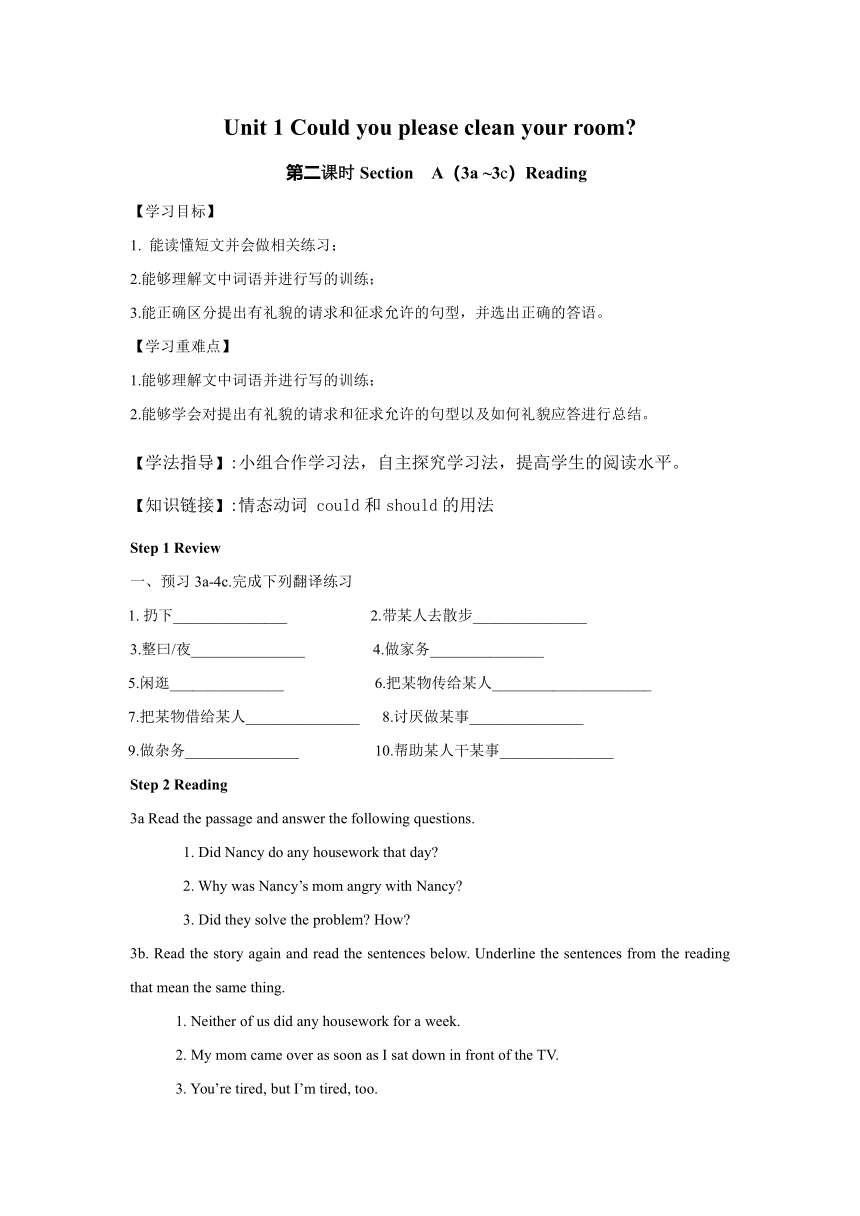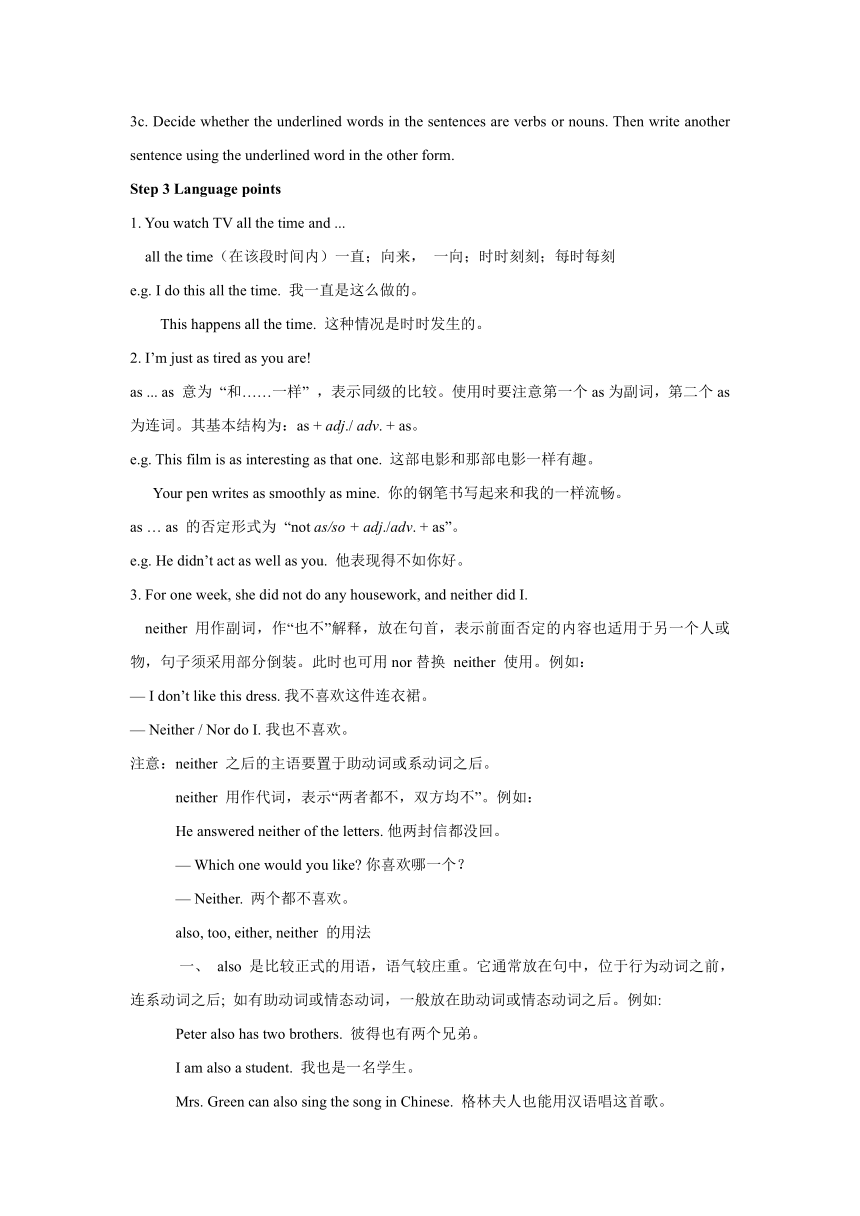鲁教(五四)版八年级上册Unit 1 Could you please clean your room?Section A A(3a ~3c)教案
文档属性
| 名称 | 鲁教(五四)版八年级上册Unit 1 Could you please clean your room?Section A A(3a ~3c)教案 |  | |
| 格式 | doc | ||
| 文件大小 | 42.5KB | ||
| 资源类型 | 教案 | ||
| 版本资源 | 鲁教版 | ||
| 科目 | 英语 | ||
| 更新时间 | 2022-10-14 10:44:11 | ||
图片预览


文档简介
Unit 1 Could you please clean your room
第二课时Section A(3a ~3c)Reading
【学习目标】
1. 能读懂短文并会做相关练习;
2.能够理解文中词语并进行写的训练;
3.能正确区分提出有礼貌的请求和征求允许的句型,并选出正确的答语。
【学习重难点】
1.能够理解文中词语并进行写的训练;
2.能够学会对提出有礼貌的请求和征求允许的句型以及如何礼貌应答进行总结。
【学法指导】:小组合作学习法,自主探究学习法,提高学生的阅读水平。
【知识链接】:情态动词 could和should的用法
Step 1 Review
一、预习3a-4c.完成下列翻译练习
1. 扔下_______________ 2.带某人去散步_______________
3.整曰/夜_______________ 4.做家务_______________
5.闲逛_______________ 6.把某物传给某人_____________________
7.把某物借给某人_______________ 8.讨厌做某事_______________
9.做杂务_______________ 10.帮助某人干某事_______________
Step 2 Reading
3a Read the passage and answer the following questions.
1. Did Nancy do any housework that day
2. Why was Nancy’s mom angry with Nancy
3. Did they solve the problem How
3b. Read the story again and read the sentences below. Underline the sentences from the reading that mean the same thing.
1. Neither of us did any housework for a week.
2. My mom came over as soon as I sat down in front of the TV.
3. You’re tired, but I’m tired, too.
3c. Decide whether the underlined words in the sentences are verbs or nouns. Then write another sentence using the underlined word in the other form.
Step 3 Language points
1. You watch TV all the time and ...
all the time(在该段时间内)一直;向来, 一向;时时刻刻;每时每刻
e.g. I do this all the time. 我一直是这么做的。
This happens all the time. 这种情况是时时发生的。
2. I’m just as tired as you are!
as ... as 意为 “和……一样” ,表示同级的比较。使用时要注意第一个as为副词,第二个as为连词。其基本结构为:as + adj./ adv. + as。
e.g. This film is as interesting as that one. 这部电影和那部电影一样有趣。
Your pen writes as smoothly as mine. 你的钢笔书写起来和我的一样流畅。
as … as 的否定形式为 “not as/so + adj./adv. + as”。
e.g. He didn’t act as well as you. 他表现得不如你好。
3. For one week, she did not do any housework, and neither did I.
neither 用作副词,作“也不”解释,放在句首,表示前面否定的内容也适用于另一个人或物,句子须采用部分倒装。此时也可用nor替换 neither 使用。例如:
— I don’t like this dress. 我不喜欢这件连衣裙。
— Neither / Nor do I. 我也不喜欢。
注意:neither 之后的主语要置于助动词或系动词之后。
neither 用作代词,表示“两者都不,双方均不”。例如:
He answered neither of the letters. 他两封信都没回。
— Which one would you like 你喜欢哪一个?
— Neither. 两个都不喜欢。
also, too, either, neither 的用法
一、 also 是比较正式的用语,语气较庄重。它通常放在句中,位于行为动词之前,连系动词之后; 如有助动词或情态动词,一般放在助动词或情态动词之后。例如:
Peter also has two brothers. 彼得也有两个兄弟。
I am also a student. 我也是一名学生。
Mrs. Green can also sing the song in Chinese. 格林夫人也能用汉语唱这首歌。
二、 too 是普通用词,多用于口语,语气较随便。一般用在肯定句中,放在句末。例如:
I’m in Row 1, too. 我也在第一排。
注意:also和too一般都用于肯定句,很少用于否定句。
三、either 表示“也”时,一般只用于否定句,且置于句末。例如:
I don’t know him. Tom doesn’t know him, either.
我不认识他,汤姆也不认识他。
If you don’t go there, he won’t go there, either.
如果你不去那儿,他也不会去那儿。
注意:either 本身没有否定的意义。所以多与 not 连用。
四、neither 表示“两个都不”,它作主语时,谓语动词常用单数。例如:
Neither of you can do it. 你们两个都不能做这件事。
达标检测
1、用所给词的适当形式填空。
1.I really hate_________(listen)to the loud music.
2.Neither of his parents_________(like)doing chores.
3.Jim spent five hours in finishing________(draw)the picture.
4.The kids saw the robot throw the ball into the box in________(surprised).
5.Tom’s mother is very busy, so he needs________(help)out around the house.
2、根据句意、汉语和首字母提示完成下列句子
1.John, please don’t t_________(扔)waste paper on the ground.
2.Could you please p_________(递)me a cup of tea
3.The boy often b__________(借)some books from our school library.
4.Jenny h__________(讨厌)doing homework on Sundays.
5.There are five f__________(手指)on each hand.
3、根据汉语意思,把下列句子补充完整。
1.那个男孩扔下书包就从教室里跑了出去。
The boy________ _______his bag and ran out of the classroom.
2.你能带小狗出去散步吗?
Could you please_______the dog_______ ______ ______
3.杰姆总是看电视,在家从不帮助做家务。
Jim watches YV______ ______ _____and never helps out around the house.
4.他划伤了左脚,他尽量不让它沾水。
He cut his left foot and he’s trying not to______ _____ _______.
5.玛丽不喜欢看体育节目,我也不喜欢。
Mary doesn’t like watching sports show and_______ ______ _______.
课堂小结:阅读的任务不仅仅是训练和提高阅读技能,也涵盖了实际交际,词汇和知识点等内容,同事它还承载着培养正确的情感态度,价值观等深层意义,培养学生分担家务的责任感。
第二课时Section A(3a ~3c)Reading
【学习目标】
1. 能读懂短文并会做相关练习;
2.能够理解文中词语并进行写的训练;
3.能正确区分提出有礼貌的请求和征求允许的句型,并选出正确的答语。
【学习重难点】
1.能够理解文中词语并进行写的训练;
2.能够学会对提出有礼貌的请求和征求允许的句型以及如何礼貌应答进行总结。
【学法指导】:小组合作学习法,自主探究学习法,提高学生的阅读水平。
【知识链接】:情态动词 could和should的用法
Step 1 Review
一、预习3a-4c.完成下列翻译练习
1. 扔下_______________ 2.带某人去散步_______________
3.整曰/夜_______________ 4.做家务_______________
5.闲逛_______________ 6.把某物传给某人_____________________
7.把某物借给某人_______________ 8.讨厌做某事_______________
9.做杂务_______________ 10.帮助某人干某事_______________
Step 2 Reading
3a Read the passage and answer the following questions.
1. Did Nancy do any housework that day
2. Why was Nancy’s mom angry with Nancy
3. Did they solve the problem How
3b. Read the story again and read the sentences below. Underline the sentences from the reading that mean the same thing.
1. Neither of us did any housework for a week.
2. My mom came over as soon as I sat down in front of the TV.
3. You’re tired, but I’m tired, too.
3c. Decide whether the underlined words in the sentences are verbs or nouns. Then write another sentence using the underlined word in the other form.
Step 3 Language points
1. You watch TV all the time and ...
all the time(在该段时间内)一直;向来, 一向;时时刻刻;每时每刻
e.g. I do this all the time. 我一直是这么做的。
This happens all the time. 这种情况是时时发生的。
2. I’m just as tired as you are!
as ... as 意为 “和……一样” ,表示同级的比较。使用时要注意第一个as为副词,第二个as为连词。其基本结构为:as + adj./ adv. + as。
e.g. This film is as interesting as that one. 这部电影和那部电影一样有趣。
Your pen writes as smoothly as mine. 你的钢笔书写起来和我的一样流畅。
as … as 的否定形式为 “not as/so + adj./adv. + as”。
e.g. He didn’t act as well as you. 他表现得不如你好。
3. For one week, she did not do any housework, and neither did I.
neither 用作副词,作“也不”解释,放在句首,表示前面否定的内容也适用于另一个人或物,句子须采用部分倒装。此时也可用nor替换 neither 使用。例如:
— I don’t like this dress. 我不喜欢这件连衣裙。
— Neither / Nor do I. 我也不喜欢。
注意:neither 之后的主语要置于助动词或系动词之后。
neither 用作代词,表示“两者都不,双方均不”。例如:
He answered neither of the letters. 他两封信都没回。
— Which one would you like 你喜欢哪一个?
— Neither. 两个都不喜欢。
also, too, either, neither 的用法
一、 also 是比较正式的用语,语气较庄重。它通常放在句中,位于行为动词之前,连系动词之后; 如有助动词或情态动词,一般放在助动词或情态动词之后。例如:
Peter also has two brothers. 彼得也有两个兄弟。
I am also a student. 我也是一名学生。
Mrs. Green can also sing the song in Chinese. 格林夫人也能用汉语唱这首歌。
二、 too 是普通用词,多用于口语,语气较随便。一般用在肯定句中,放在句末。例如:
I’m in Row 1, too. 我也在第一排。
注意:also和too一般都用于肯定句,很少用于否定句。
三、either 表示“也”时,一般只用于否定句,且置于句末。例如:
I don’t know him. Tom doesn’t know him, either.
我不认识他,汤姆也不认识他。
If you don’t go there, he won’t go there, either.
如果你不去那儿,他也不会去那儿。
注意:either 本身没有否定的意义。所以多与 not 连用。
四、neither 表示“两个都不”,它作主语时,谓语动词常用单数。例如:
Neither of you can do it. 你们两个都不能做这件事。
达标检测
1、用所给词的适当形式填空。
1.I really hate_________(listen)to the loud music.
2.Neither of his parents_________(like)doing chores.
3.Jim spent five hours in finishing________(draw)the picture.
4.The kids saw the robot throw the ball into the box in________(surprised).
5.Tom’s mother is very busy, so he needs________(help)out around the house.
2、根据句意、汉语和首字母提示完成下列句子
1.John, please don’t t_________(扔)waste paper on the ground.
2.Could you please p_________(递)me a cup of tea
3.The boy often b__________(借)some books from our school library.
4.Jenny h__________(讨厌)doing homework on Sundays.
5.There are five f__________(手指)on each hand.
3、根据汉语意思,把下列句子补充完整。
1.那个男孩扔下书包就从教室里跑了出去。
The boy________ _______his bag and ran out of the classroom.
2.你能带小狗出去散步吗?
Could you please_______the dog_______ ______ ______
3.杰姆总是看电视,在家从不帮助做家务。
Jim watches YV______ ______ _____and never helps out around the house.
4.他划伤了左脚,他尽量不让它沾水。
He cut his left foot and he’s trying not to______ _____ _______.
5.玛丽不喜欢看体育节目,我也不喜欢。
Mary doesn’t like watching sports show and_______ ______ _______.
课堂小结:阅读的任务不仅仅是训练和提高阅读技能,也涵盖了实际交际,词汇和知识点等内容,同事它还承载着培养正确的情感态度,价值观等深层意义,培养学生分担家务的责任感。
同课章节目录
- Unit 1 Could you please clean your room?
- Section A
- Section B
- Unit 2 Why don't you talk to your parents?
- Section A
- Section B
- Unit 3 What were you doing when the rainstorm came
- Section A
- Section B
- Unit 4 An old man tried to move the mountains.
- Section A
- Section B
- Unit 5 What's the highest mountain in the world?
- Section A
- Section B
- Unit 6 Have you read Treasure Island yet?
- Section A
- Section B
- Unit 7 Have you ever been to a museum?
- Section A
- Section B
- Unit 8 I've had this bike for three years.
- Section A
- Section B
